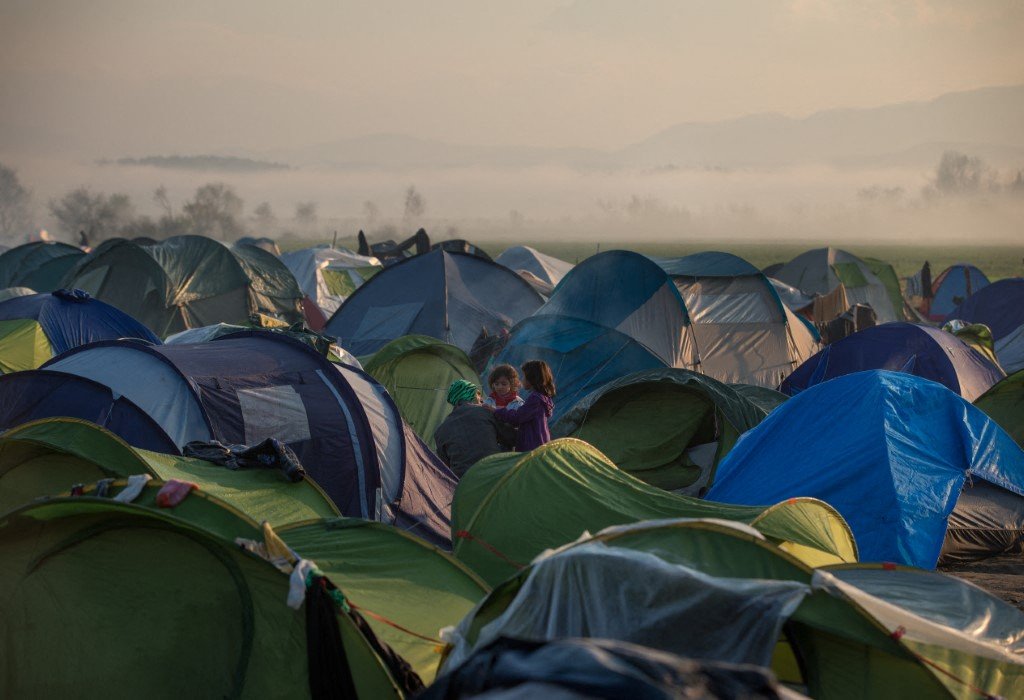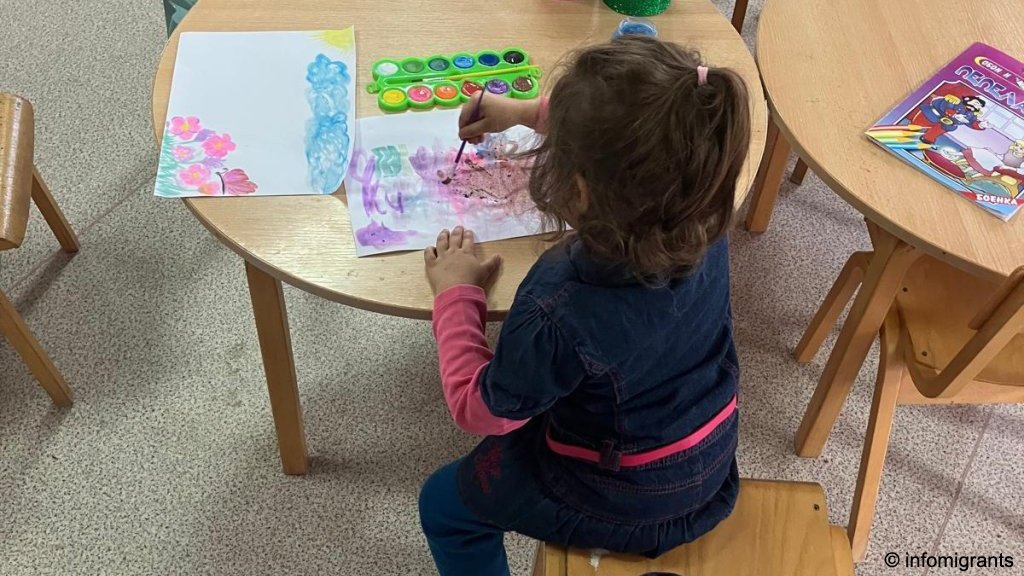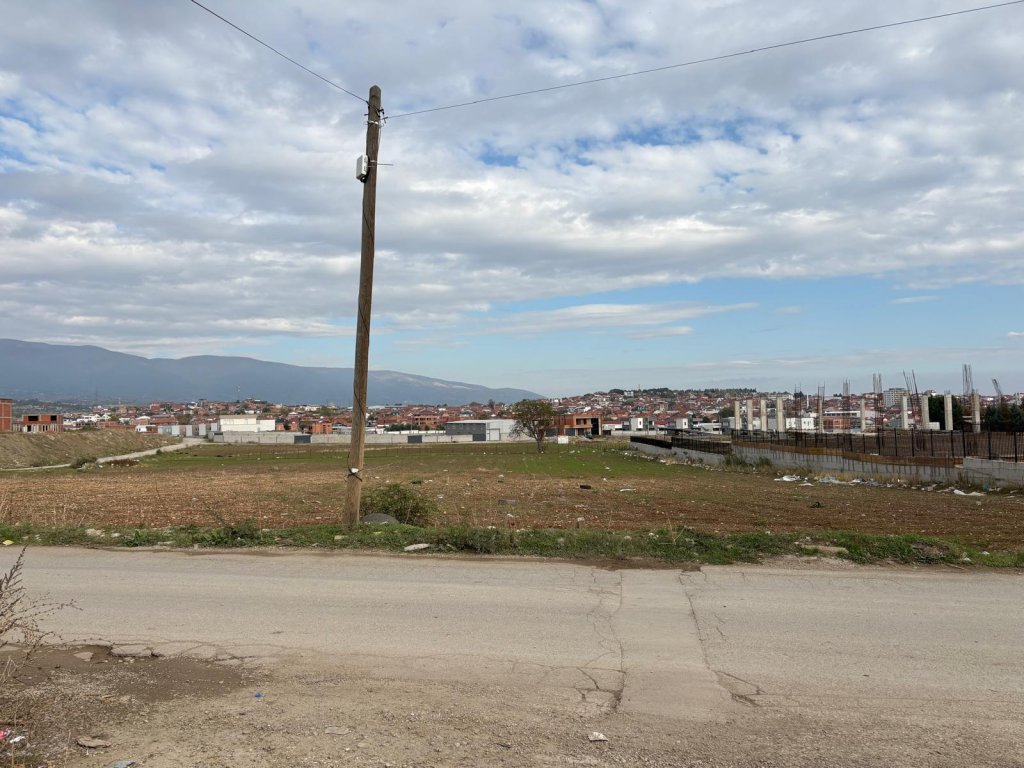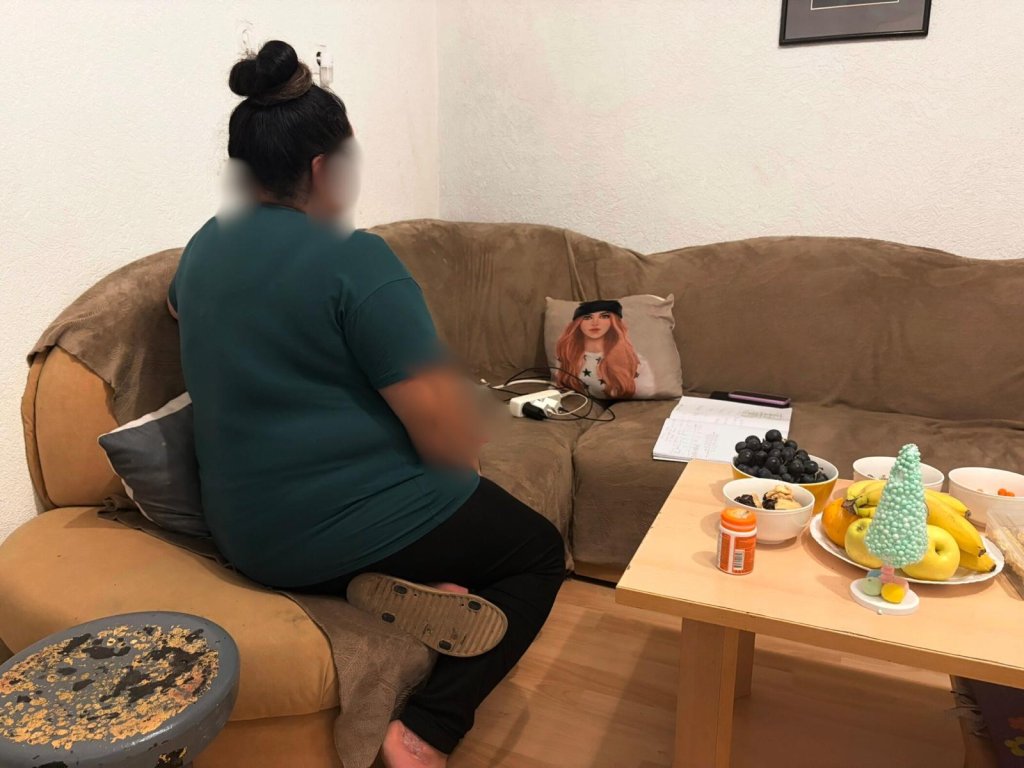North Macedonia is a transit country for migrants coming from Greece hoping to reach Western Europe. Asylum is rarely granted in this small, non-EU country, and it's mostly vulnerable persons like the wounded, families or unaccompanied minors who apply for it. Most often, they do so to have just a few weeks of peace before they go back on the road.
On a grey October day, Lal Mohammad is standing between two container rows, wearing a white T-shirt imprinted with pictures of satellites and cosmonauts. The 25-year-old and his wife just registered their fingerprints in the Vinojug transit center, south of North Macedonia, at the border with Greece. Their little 3-year-old daughter, Asra, is drinking a glass of apple juice on a bench, amused by a cat wandering by her. The family applied for asylum a month ago, as soon as they entered Macedonian territory.
After an unsuccessful crossing through Evros, the land border between Turkey and Greece, this Afghan family reached Greek ground after four days and nights at sea. All three spent several days in the closed Thessaloniki camp before being transferred to a second camp close to the Macedonian border. "There, we were told that [in order to have an appointment to apply for asylum], we’d have to wait a year and a half… We didn’t want to wait that long. So we went to the forest [at the border between Greece and North Macedonia, editor’s note] to try the game," he says. 'The game' is a term used by migrants to describe border crossing attempts.

The family was stopped by Macedonian police and put in the Vinojug transit center, the only processing center at the country's border with Greece. There, they first interacted with Frontex, which has been present in the country since the summer of 2023. Like all asylum seekers stopped there, they had two options: either "voluntary return" to Greece or officially apply for asylum.
'I asked ChatGPT for help: what should I do?'
Lal Mohammad did not hesitate: There was no way he would return to the forest to try the "game" again with his wife and 3-year-old daughter. But the smuggler, whose profits depend on migrants staying on the move, put him under intense pressure. Lal Mohammad explains that the smuggler demanded 4,000 euros for the crossing from Turkey to Greece, and 800 euros to go to Serbia from Macedonia.

"He harassed us, would call every day, telling us: 'Come back to Greece.' I would answer: 'I’m not going to run away, don’t worry, the money is here, I have a child and a wife, I can’t go back just like that,' then I turned my phone off for a few days." The father was in distress: "I even asked ChatGPT for help: 'What should I do, the smuggler calls me every day and I don’t know what to do?' ChatGPT told me to talk to the center officials."
Applying for asylum in Vinojug means staying for a month in that deserted transit center. Its grey containers host NGO offices, many of which have been empty for years. The posters on the doors have decomposed with time. Built in 2015, at the height of refugee and migration movements to Europe, the center's infrastructure is now left in decay.
At the far end of the camp, containers are lined up, each containing six bunk beds. Most of them are empty. That day, only a few dozen people were in the camp. In the first three weeks of October, a total of 320 asylum seekers passed through the site. In the damp toilets, one can hear the continuous drop of water from a leak.
Only 149 asylum applications in 2025
After one month spent in the center, asylum seekers are transferred to the capital city Skopje. There, applicants are housed in the only center for asylum seekers in the country, in Vizbegovo, in the suburbs.
"I hope we'll resume our journey soon," Lal Mohammad tells InfoMigrants. The father does not actually wish to stay in North Macedonia. He just wants some respite for his family on a trying journey to safety.

North Macedonia is a transit country on the Balkan route before anything else. The small country of only 2 million is surrounded by Greece, Bulgaria, Serbia, Kosovo, and Albania, and it is not in the EU nor in Schengen. It lies along the main route from Greece to reach Serbia, before getting to Western Europe.
In 2024, a total of 4,055 people from 35 countries registered in the Vinojug center. But the Macedonian Young Lawyers Association, which specializes in asylum procedure assistance, only recorded 307 asylum applications. Only 131 of these were recorded in Vinojug.
In 2025, the number will probably be even lower: Since the beginning of the year, 149 asylum applications have been recorded. Most of them are Syrians (46 people), followed by Nepalese, Iraqis, Turks, Afghans and Egyptians. Some go through with their application, but many only wish to recover and rest a bit before resuming their journey to Serbia or Kosovo.
'Nobody wants to stay in North Macedonia'
Two days later, we find Asra, the little 3-year-old, seated on a rocky path a few dozen meters away from the center for asylum seekers of Vizbegovo. Next to her is Mohamad Azim, a 16-year-old teen, standing and watching over her. The young Afghan kid looks intently at her, then kneels next to her and opens his arms in an embrace. She runs to nestle herself against the young teen’s green sweater.

Mohamad Azim met Asra and her parents at the Vinojug center. Like them, the teen applied for asylum. But he also doesn't want to stay. "Nobody wants to stay in North Macedonia. If I could, I would leave right away to Serbia," he says. The teenager applied for asylum to get some rest. He is tired from the border, the nights spent in the forest, the cold, the rain. "We didn’t have anything to eat or drink. We fed from the few grapes we would find."
He was also pressured by the smuggler for having paused his journey. “He would call me relentlessly to tell me: ‘What are you doing there, come back to Greece, I’ll make it so you cross the border again to get to Serbia.’” The young man took time to think and review his plans. He no longer hopes to reach Italy. He now wants to go to Switzerland and ask for protection there.
Mandatory stop for the wounded
Others stop at Vizbegovo simply because their body will not let them go any further. Mohamed, 25, from Morocco, has been stuck here for a month because of a leg injury. “I left Turkey in June. I was alone, and I tore the back of a truck’s tarpaulin with a knife to get in and reach Greece. Once in Greece, I jumped while the truck was moving, and ended up with a fracture in my right leg."

With the help of a group of young people, he continued his journey to cross the Macedonian border with his broken leg. After he was stopped and brought to the Vinojug transit center, the Red Cross took him to the Skopje hospital. “I underwent surgery, my leg was put in a cast, and I have gotten better since. I’ve been walking with a crutch. But I want to continue my journey. I’m just waiting for my leg to heal."
The Vizbegovo asylum seeker center has capacity for 90 people, and was renovated in the past few years thanks to 700,000-euro funding from the Council of Europe’s Development Bank, through the IOM. Although the center seems fine from the exterior — InfoMigrants was not allowed inside — and authorities claim a doctor visits regularly, the conditions inside are not always satisfying, according to the migrants InfoMigrants met.
"We don’t have enough food here, with only one meal a day, at noon, to keep us alive," Mohamed sighed. Kayum Arubi, a 17-year-old Afghan, agrees: “The center is not very clean and the food, served once a day, is bad."

Usually, asylum applications are not successful. "Unfortunately, most decisions are negative. Asylum seekers have 30 days to appeal to the administrative court,” Mitko Kiprovski, lawyer and migrant advocacy officer of the Jesuit Refugee Service (JRS) NGO, told InfoMigrants. If their first appeal fails, asylum seekers can go up to the Skopje High Administrative Court. But if the second appeal fails, they have to leave the territory within 20 days.
Mariam*, one of a handful of admitted refugees in North Macedonia
As a result, North Macedonia has granted only a handful of international protections in the last few years. In 2024, following a North Macedonia mission, the UN Torture Committee rapporteurs reported that only three people were under subsidiary protection in 2023, and no refugee status was granted between 2016 and 2023. The fact that the country is not in the EU -- even if its application is pending -- means the asylum criteria are less scrutinized than in other places.
Two years later, in 2025, there are only five refugees in North Macedonia (one Congolese woman, one Syrian woman, and their children) and two people with subsidiary protection living in the country (an Afghan man and a Moroccan man). The third person to receive subsidiary protection, an unaccompanied Syrian minor, left the country. Same thing for an Afghan man who has received refugee status.
Mariam*, 30, is one of those exceptions, living in Skopje. After giving birth in Greece, this Syrian woman crossed the border with North Macedonia in 2018 while she was still breastfeeding her daughter. The dangers of border crossing also put a stop to her journey. Between Greece and Macedonia, "police put their spotlights on our group. Everyone fled around me. I also started to run, carrying my daughter, but I fell into a hole and broke my leg." Once arrived at the Vinojug transit center, she was taken care of by JRS and transferred to the Skopje hospital for treatment.

In the years that followed, JRS helped her with her asylum and housing procedures, until Mariam was granted asylum. The NGO still monitors her situation. The Red Cross, meanwhile, employed her for a bit before finding her a job in a restaurant, and taught her Macedonian -- a real challenge for Mariam, who is illiterate. Her daughter is now 9. She is in school, learning Macedonian, more easily thanks to her young age. And when it comes to Mariam’s leg, after all these years, "I still have pins… I have to get them removed soon," she said.
Even if Miriam still struggles to learn the language and meet her daughter’s needs with her small wage, she says that "here is better than Greece. There, I was always afraid. I never felt comfortable. Here, I have Macedonian friends I see and who come to see me, I work, and I don’t need anyone’s help."
*Mariam's real name was changed to protect her privacy.
